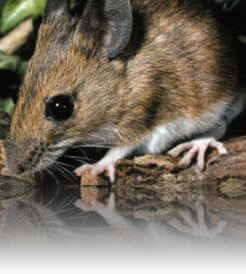Mice Control: Protect Your Home or Business
Facts
- The three main types of mice in the Mid-Atlantic area are house mice, white-footed mice, and deer mice.
- This pest can fit through a hole the size of a dime.
- Depending on the species, these rodents can multiply quickly, having as many as eight litters of five to eight pups per year.
Appearance

House mice are five to eight inches long with tails that make up about half of their total length. The house mouse has smooth gray fur and a mostly naked tail. On the other hand, deer and white-footed mice are slightly larger, with bigger eyes and ears. They have a reddish-brown coloring and white bellies and feet.
How Do Mice Get Inside Buildings?
Human structures offer plenty of food and nesting material for mice. Excellent climbers, these pests can scale siding and cross wires to enter homes. A hole that’s a quarter of an inch in diameter is all a house mouse needs, so they can come in through gaps around windows and doors, as well as unsealed pipes or torn screens.
Most businesses are vulnerable, too. Restaurants, cafeterias, nursing homes, and grocery stores provide easy meals for mice. Warehouses and factories with open loading docks make it simple for them to get in. Uninhabited buildings, such as storage facilities or vacant rental properties, may also be more likely to have deer mice.
Signs of Mice Infestation
- Sighting – You may spot a mouse as it travels to or from its nest.
- Runways – Mice use the same paths over and over again, leaving greasy smudges along walls and woodwork.
- Droppings – If you see dark, rice-sized pellets in the pantry or along baseboards, you probably have a mouse problem.
- Noise – These pests are nocturnal, so you may hear chewing, squeaking, or movement at night.
Problems Caused by Mice
Mice present a wide range of issues to homeowners and businesses alike. These rodents are voracious chewers, which can lead to expensive structural damage and ruined furniture. Moreover, this pest likes to gnaw on electrical cords, which creates a fire hazard. A mouse might also shred insulation, linens, and clothing to build nests.
In addition to being destructive, mice eat and contaminate food, causing costly losses in the service industry. On top of this, deer and white-footed mice can spread hantavirus. You can get this respiratory infection when you inhale dust around dried droppings or urine.
Prevention Tips
The easiest way to keep mice out is by repairing holes in foundations, walls, and roofs. Seal doors and windows and make sure your screens are free of tears. You should also keep food in air-tight containers and clean kitchen surfaces regularly. If you still have a mouse problem, contact Western Pest Services and speak with a professional today.